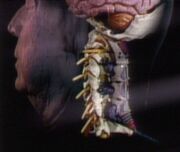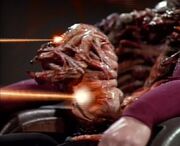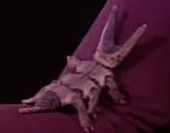The bluegill, more commonly referred to simply as parasites, were a parasitic genetically modified off-shot the Trill symbionts created to try and cure the symbionts of a terrible disease. The experiments failed resulting instead in a race of psychopaths which the Trill tried and failed to eradicate. From then on the parasites maintained a hatred for the Trill and by various means attempted to destroy them.
- The name bluegill comes from the Star Trek: Customizable Card Game.
Biology
The Parasites were insect-like in appaearence and took control of their victims by crawling down his or her throat and tapping directly into their brain and spinal cord. The process was eventually fatal to the victim.
In addition to an impressively fast crawl speed for such small creatures the parasites were capable of jumping the height of most humanoids to quickly gain access to the mouth. They had a large set of strong pinchers which they used to force there way into more resistant hosts.

The neurological connection between host and parasite
The parasites shared the same kind of isoboromine neurotransmitter links with their hosts as Trill symbionts, but, unlike Symbionts, they take complete control of their host. The only physical clue to a parasite's existence is a small barb that protrudes from the back of the host's neck, but in later incursions the parasites learned to cover that up by plastimasking it onto the host's skin. The barb acts like a gill, expelling spent gases taken from the host's blood absorbed through pores in the parasite's exoskeleton. Regular parasites have neither eyes or a mouth.
A parasite infected host could be detected by changes in behavior. Hosts tended to develope trembling fingers and rapid eye movement as well as a taste for Klingon and Ferengi food, both of which include vermiform invertebrates. The parasites could access the short term memory of the host, but not the long term, which could give them away as a parasite controlled host would be unable to answer detailed questions about the host's own past accurately. However, even once uncovered, the host is immune to phaser stuns due to the parasites ability to neutralize their victims pain receptors and controlling adrenalin levels. This also gives the host increased strength, making subduing a host difficult.

A parasite spawnmother
The parasites could function independently, but it's believed that they prefer to work in hives with a queen telepathically communicating and controlling other soldier parasites, and possibly communicating with other queens. The parasites could be removed from their hosts, but only within three-four weeks of bonding (or less, depending on the species), after which the neurological connections become too complex and the host-body would be killed - permanent connection with a joined trill takes less than a day whilst Cardassians seemed to be immune to infection by the parasites. The exception to this is when the queen parasite is killed, in such a case the soldier parasites release control of their hosts and are then relatively easily removed or indeed leave their victims voluntary with no harm to the host. (DS9 novel: Unity; TNG episode: "Conspiracy")
Breeding Hierarchy
The parasites breed with a structure similar to that of colonial insects.
Each encounter with the parasites was the result of the efforts of one spawnmother. A spawmother could create thousands of offspring to do her bidding and could use her telepathic abilities to effectively remote control the hosts of her spawn. The spawnmother could produce both queen and soldier parasites. The queens born with implanted young could then spread the colony further infecting more hosts as necessary or desired. The soldiers were incapable of reproduction and took commands from queen or spawnmothers. (DS9 novel: Unity)
Types
- Spawnmother parasite
- Queen parasite
- Soldier parasite
History
Creation
The Parasites were created on an ancient Trill colony on the planet Kurl in the 3rd millennium BC. The Kurlans, were a group of joined Trill who set about making a society of only joined persons on Kurl, unfortunately something on the planet went wrong and a virus infected much of the population, in a short time ten percent of the colony had died. As the virus most acutely affected the symbionts, the scientists from the colony went about genetically modify them to make them more resistant. In the process, the scientists learnt a joining would be more effective if it occurred at the brain stem so they modified the symbionts with pincers necessary to burrow into the neck. However the experiments were unsuccessful and the virus adapted and after ten years of experimentation the result was a race of mutilated symbionts, which had gone mad from the experience and started taking complete control of their hosts. The Trill resorted to genocide, killing four million of mutilated parasites, then in fear, they retreated to Trill which ended the first Trill space age and resulted in them becoming isolated from the galaxy for centuries - not forgetting what had happened on their colony. But some parasites survived, and they did not forget what the Trill had done to them which was the source of their resentment to the Trill for millenia. (DS9 novel: Trill: Unjoined)
First Contact
In 2265, a team that included Starfleet Captain Christopher Pike, and Trill representatives Audrid Dax and Jayvin Vod investigated a comet heading towards Trill that was inhabited by a previously unknown lifeform. The team discovered a parasitic lifeform, which took control of Vod, eventually resulting in his death. Also killed were three of the Starfleet officers also on the expedition.
The Vod-parasite revealed to Dax and Pike that his species had a hatred of all humanoid life, and the Trill in particular. The parasite called itself "the taker of gist". After the Vod-paraiste was defeated, it was discovered that the parasites were almost genetically identical to Trill symbionts, and that they were en route to Trill in the first step in a long-reaching plan for vengence.
The Trill government covered up the incident by destroying the comet and allowing the parasite-infected Vod symbiont, whose identity had been destroyed by the Parasite, to die rather than be placed in a new host. (DS9 short story: "Sins of the Mother")
Starfleet Conspiracy

In 2364 several members of Starfleet started to become increasing suspicious having noted unusual orders coming from Starfleet Command and uncharacteristic behaviour from other members of Starfleet. These suspicions cumulated with the USS Enterprise returning to Earth, there the crew of the Enterprise discovered a parasitic alien race had gained control of much of Starfleet HQ. Having uncovered the conspiracy Captain Jean-Luc Picard and this First Officer Will Riker confronted several parasite infected Starfleet personal and located the spawnmother. Together they killed the Parasite spawnmother ending the coup. (TNG episode: "Conspiracy")
Later analysis of the Parasites tactics revealed they were placing heavy fire power near to the planet Trill in preparation for an attack. (DS9 novel: Unity)
Onglaatu
In 2368 the parasites attempted to start a civil war on the planet Onglaatu, whatever their motivations were, their plan was stopped by Lieutenant Commander Geordi La Forge of the Enterprise. (TNG comic: "The Broken Moon")
Bajor
In 2376 the Parasites began another ploy, this time to take over the Bajoran sector. The Bajoran First minister Shakaar Edon was on a tour of Federation space was on the planet of Minos Korva when he stumbled across a lone spawnmother parasite who had thought she was the last of her kind. This spawnmother she took the opportunity to take Shakaar as host and traveled with him back to Bajor.
On Bajor she started to spawn and take control of hosts all over Bajor and Deep Space 9, using Shakaar she instructed Asarem Wadeen to make peace talks with the Cardassians difficult and prolonged to prevent Cardassian interference with her plans. The spawnmother's presence ate away at Shakaar's personality until there was nothing left. Hiziki Gard's assassination of Shakaar alerted Starfleet to the situation and the Bajoran system was locked down by a Cardassian force led by Gul Macet.
At some point prior to the assassination she presumably left Shakaar leaving a soldier or queen parasite in her place, this also gave her the opportunity to start a mass spawn, growing far larger than Shakaar would have been able to contain. Even when Starfleet successfully captured a queen the parasites remained confident that they would win and demanded all humanoids to leave the Bajoran system to them. The spawnmother's eventual goals were to use the knowledge and power of the Bajoran Orbs to strike out at Trill and her allies. It was, however, the orbs that were her eventual undoing. She was located by Kira Nerys in the orb room at Ashalla and, facing unwinnable odds, Kira opened all the orb arks, exposing the spawnmother to all eight. In the ensuing orb experience she was sent by Benjamin Sisko to a void of a realm inhabited by a small number of Jem'Hadar. With the disappearance of the spawnmother, the remaining parasites abandoned their hosts, ending the attack. (DS9 novels: Unity, Lesser Evil)
Connections
- Bluegill article at Memory Alpha, the wiki for canon Star Trek.
